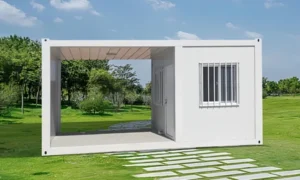In the wake of natural disasters, providing safe and rapid shelter is critical. Carter’s foldable container house for disaster relief offers a practical and scalable solution for emergency housing.
The Essential Role of Foldable Container Houses in Disaster Response
Addressing Immediate Shelter Needs Post-Disaster
Foldable container houses are essential for quick and effective housing solutions in the aftermath of disasters. These portable homes are able to be faster housed in the sites where they are needed, promoting swift relocation to disaster-hit areas. These portable homes are invaluable. With foldable container houses, the need for swift shelter post disaster can efficiently be provided. Such container homes guarantee shelter for displaced individuals. There is a concerning reality of the emergency shelters provided. There is no doubt that they assist thousands within days of a disaster.
Advantages Over Traditional Relief Housing Methods
Foldable container houses’ primary advantage in comparison to tents and other traditional housing methods is their durability. With windows and additional features, the closed container homes are able to promote better hygiene conditions adding to the overall the health of the population.
Flat-Pack Design for Quick Installation
Foldable container houses use a flat-pack design to deliver quick shelter solutions efficiently to disaster-stricken areas. Their compact structure enables easy storage and transportation, ensuring rapid deployment to affected zones. Even untrained personnel can assemble these units on-site within hours due to their streamlined configuration. Industry reports confirm that this efficiency significantly shortens the critical gap between a disaster and safe housing, helping reduce suffering and accelerate recovery.
Built to Withstand Extreme Weather Conditions
High-Grade Steel Frame Construction
The frames of foldable container houses are made from high-grade steel that maintains the structural integrity of the house during harsh weather conditions. This type of build greatly reduces the risk of collapse or damage, providing reliable shelter even in the most difficult environments. An engineering analysis has shown that these uniquely designed steel buildings can endure wind gusts of up to 180 mph. This feature becomes crucial in regions that are frequently hit by hurricanes and tornadoes, ensuring the occupants suffer no harm from strong winds.
Thermal Insulation for Diverse Climates
The thermal insulation technology used in foldable container houses ensures that the internal environment can be suitable and comfortable for occupants. The advanced insulation works to greatly reduce the amount of energy necessitated for heating and cooling, making the house more resource-efficient. Research on insulated houses has shown that there are no negative effects on the environment. These homes decrease the use of external heating or cooling systems which shrinks the overall costs and provides more eco-friendly alternatives that are more appealing and easier to live in.
Weatherproofing Against Floods and High Winds
The thermal insulation technology used in foldable container houses ensures that the internal environment can be suitable and comfortable for occupants. The advanced insulation works to greatly reduce the amount of energy necessitated for heating and cooling, making the house more resource-efficient. Research on insulated houses has shown that there are no negative effects on the environment. These homes decrease the use of external heating or cooling systems which shrinks the overall costs and provides more eco-friendly alternatives that are more appealing and easier to live in.
Optimized for Efficient Transportation
Space-Saving Foldable Configuration
Foldable container houses are ingeniously designed to maximize space efficiency, allowing several units to be transported simultaneously. This innovative configuration dramatically reduces the number of trips needed for delivery to disaster areas, thus optimizing resource usage and minimizing delays in housing provision. Logistical studies highlight that these compact designs lead to significant reductions in transportation costs and time, making them an ideal choice for rapid deployment in urgent situations.
Reduced Logistics Costs and Storage Requirements
The foldable design of container houses leads to lower logistics costs by minimizing the need for extensive storage facilities before deployment. With fewer resources required for transport and storage, overall operational costs decrease, thereby enhancing the cost-effectiveness of relief efforts. Foldable container houses have repeatedly demonstrated in financial reports from disaster missions that they can achieve substantial savings compared to traditional housing methods, enabling responders to redirect more funds toward other critical aspects of disaster recovery.
Transportation Success in Remote Disaster Zones
Foldable container houses have proven their versatility and reliability by being successfully transported to remote and hard-to-reach disaster zones. Field reports from humanitarian missions demonstrate efficient transportation of these homes even in challenging terrains, such as mountains or flood zones. These successful transport cases reinforce the argument for foldable houses as the preferred choice in disaster response logistics, ensuring that aid reaches those who need it most in a timely and efficient manner.
Sustainable and Economical Shelter Solutions
Reusable Structures for Multiple Disaster Cycles
Foldable container houses are undeniably designed for reuse, offering communities a sustainable option through multiple disaster cycles. Their robust nature ensures that these structures can withstand the wear and tear of repeated use, potentially only needing minor repairs or refurbishments over time. This longevity significantly reduces waste and diminishes the carbon footprint typically associated with traditional single-use shelters. Statistical data supports this by showing that reusing materials and structures contributes to a more sustainable approach in managing disaster relief operations.
Cost Comparison with Temporary Tent Solutions
Comparative analyses indicate that while traditional tents might appear cheaper upfront, they may incur higher costs over time compared to foldable container houses. Tents, often designed for short-term use, tend to require frequent maintenance and replacement, making them less viable economically in the long run. On the other hand, foldable container houses provide a stable, more reliable shelter solution that saves resources and funds over extended periods. Economic studies consistently show foldable container solutions to be more cost-effective, ultimately offering better value for money in sustained relief efforts.
Low-Maintenance Design for Long-Term Use
The low-maintenance aspect of foldable container houses is a significant advantage, especially for agencies searching for sustainable housing solutions. Unlike traditional shelters, these structures require minimal upkeep, allowing agencies to redirect resources to other critical recovery operations. Field evaluations suggest that communities benefit from reduced maintenance costs as time progresses, reinforcing the economic viability and sustainability of these foldable houses. Their design not only prioritizes long-term use but also aligns with broader sustainability goals by decreasing the overall burden on logistical and financial resources.
Versatile Applications Beyond Housing
Mobile Medical Clinics in Epidemic Response
Foldable container houses are uniquely suited to be transformed into mobile medical clinics, offering crucial healthcare services during epidemic outbreaks. Their rapid setup and mobility allow medical teams to deploy swiftly, reaching affected populations and improving health outcomes. For example, during health crises, such as the Ebola outbreak, mobile clinics have significantly reduced morbidity and mortality rates by facilitating timely medical care.Foldable container houses demonstrate remarkable adaptability, making them invaluable tools in healthcare responses by enabling responders to establish and operate medical facilities effectively in challenging environments.
Emergency Storage for Relief Supplies
These versatile structures also serve as effective emergency storage units, safeguarding relief supplies from environmental damage. Their durability and security features ensure that goods remain protected until they reach those in need. In times of disaster, efficient supply chain management is crucial, and using foldable container units can enhance this efficiency. Disaster response teams highlight in their reports how these containers prevent spoilage and secure essential materials, enabling them to distribute necessary supplies quickly and efficiently to affected communities.
Customizable Layouts for Community Facilities
The modular design of foldable container houses facilitates customization, making them ideal for various community facilities such as schools or community centers. Their flexible layouts cater to the diverse needs of communities, both during and post-disaster, promoting social recovery and cohesion. Analysis of community-based projects indicates that these adaptable facilities significantly enhance resilience, speeding up rebuilding efforts and providing a sense of normalcy. By offering versatile and customizable spaces, foldable container houses contribute to restoring community dynamics and support structures in the aftermath of disasters.
Request a Free Quote Now:
📱 WhatsApp/Phone:+86-13081655379
💬 [Facebook Messenger]
📧 Email: admin@carteroom.com



